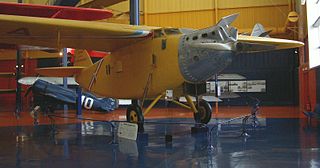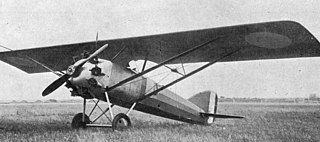Related Research Articles

Gourdou-Leseurre was a French aircraft manufacturer whose founders were Charles Edouard Pierre Gourdou and Jean Adolphe Leseurre.

The Bernard 190 or Bernard-Hubert 190 was a French airliner of 1928. It was a high-wing cantilever monoplane of conventional configuration, based on the Bernard 18. Compared with its predecessor, it kept the same basic design but featured redesigned tail surfaces, an enlarged cabin, and offered its flight crew a completely enclosed cockpit. Also like its predecessor, the basic airliner model provided the basis for a long-range aircraft to be used in record attempts, the 191GR.

The CAMS 55 was a reconnaissance flying boat built in France in the late 1920s which equipped the French Navy throughout the 1930s.

The Gourdou-Leseurre GL-812 HY was a 3-seat reconnaissance floatplane, built by Gourdou-Leseurre.

The Farman F.120 and its derivatives were a family of multi-engine airliners and bombers of the 1920s built by the Farman Aviation Works in France.

The Morane-Saulnier MS.230 aircraft was the main elementary trainer for the French Armée de l'Air throughout the 1930s. Almost all French pilots flying for the Armée de l'Air at the outbreak of World War II had had their earliest flight training in this machine. It was the equivalent of the Stearman trainer in the United States air services and the de Havilland Tiger Moth in the British Royal Air Force.

The Gourdou-Leseurre GL-832 HY was a 1930s French light shipboard reconnaissance floatplane design and built by Gourdou-Leseurre for the French Navy.

The Farman F.300 and F.310 were airliners built in France in the early 1930s. They were high-wing strut braced monoplanes with fixed tailskid undercarriage with a trimotor layout popular with several manufacturers of the time. The cockpit and passenger compartment were fully enclosed. Most saw service in Farman's own airline, whose twelve F.300 variants made up half its fleet in 1931.

The FBA 17 was a training flying boat produced in France in the 1920s.

The Gourdou-Leseurre GL.30 was a racing aircraft built in France in 1920 which formed the basis for a highly successful family of fighter aircraft based on the same design.

The Morane-Saulnier Vanneau is a two-seat basic trainer built in France by Morane-Saulnier and ordered by the French Air Force.
The Gourdou-Leseurre GL.50, also known as the Gourdou-Leseurre Type F, was a French fighter prototype of the early 1920s.

The Levasseur PL.7 was a torpedo bomber developed in France in the late 1920s. It was a development of Levasseur's PL.4 reconnaissance aircraft and intended to replace their PL.2 then in service with the Aéronavale. It was a single-bay biplane of largely conventional design, but incorporating safety features for naval operation, including jetissonable main undercarriage units, a watertight, boat-shaped fuselage, and small floats on the undersides of the lower wings.

The Lioré et Olivier H-190 was a flying boat airliner produced in France in the late 1920s. Conventional for its day, it was a single-bay biplane with un-staggered wings, its single engine mounted tractor-fashion underneath the upper wing and supported on struts in the interplane gap. Early examples had the pilot's open cockpit located aft of the wing, but this was later relocated forward of the wing.

The Farman NC.470 was a French twin-engined floatplane designed as a crew trainer for the French Navy. It was used in small numbers for both its intended role as a trainer and as a coastal reconnaissance aircraft at the start of World War II.
The Farman F.150 was a 1920s French twin-engined biplane designed by Farman as a day bomber.

The Potez X was a French 1920s general-purpose colonial transport aircraft designed and built by Potez.

The Blériot-SPAD S.91 was a French light-weight fighter aircraft. It would be later developed into the Blériot-SPAD S.510, the last biplane produced by the French aeronautic industries.
The Hanriot H.34 was a basic trainer designed in France in 1924 which did not reach production. It was a parasol wing aircraft, seating two in tandem.

The Levasseur PL.200 was an observation seaplane built by Levasseur in the mid-1930s. It was a high-wing monoplane with a short, all-metal fuselage nacelle at mid-span, and a wing made of metal.
References
- 1 2 Parmentier, Bruno (29 April 2003). "Gourdou Leseurre GL-820 HY". Aviafrance (in French). Paris. Retrieved 1 February 2019.
- 1 2 Parmentier, Bruno (5 August 2001). "Gourdou Leseurre GL-821 HY". Aviafrance (in French). Paris. Retrieved 1 February 2019.
- 1 2 Parmentier, Bruno (29 April 2003). "Gourdou Leseurre GL-821 HY 02". Aviafrance (in French). Paris. Retrieved 1 February 2019.